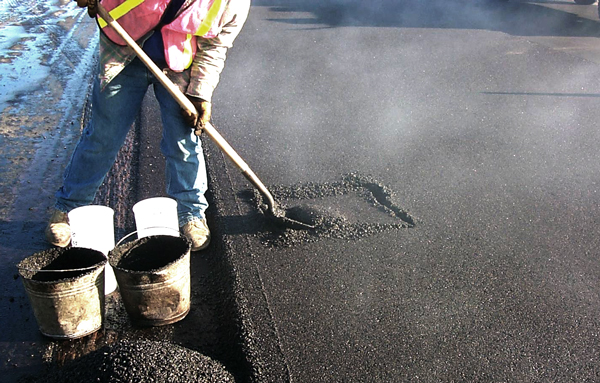Hot Mix Asphalt Paving: Redefining Commercial Building Landscapes
Hot Mix Asphalt Paving: Redefining Commercial Building Landscapes
Blog Article
Unlocking the Tricks of Warm Mix Asphalt Modern Technology
Checking out the depths of warm mix asphalt modern technology reveals a globe where thorough processes and specific solutions converge to form our roadways and framework. The combination of fillers, accumulations, and binders isn't simply a construction task however a tactical orchestration of longevity and performance. As we peer right into the complex dancing of parts, a tapestry of resilience and sustainability unfolds. What lies beneath this surface of asphaltic proficiency, and what secrets wait to be revealed in the realm of paving innovations?
Value of Hot Mix Asphalt
Warm Mix Asphalt plays a critical function in modern-day facilities development because of its toughness and cost-effectiveness. As the most commonly utilized leading material for roadways, highways, and parking area, Warm Mix Asphalt uses a variety of benefits that contribute to its significance in construction jobs. One essential benefit is its ability to hold up against rush hour lots and rough weather condition conditions, giving a dependable and long-lasting surface area for transport networks. Additionally, Hot Mix Asphalt is economical in both first building and lasting maintenance, making it a preferred option for numerous facilities tasks.
The sturdiness of Hot Mix Asphalt stems from its structure, which consists of accumulations, binder, and filler materials that are carefully picked and mixed to meet specific performance demands. Overall, the relevance of Hot Mix Asphalt in facilities development can not be understated, as it proceeds to be a keystone of modern construction practices.
Components of Asphalt Mixes
The make-up of asphalt mixes is composed of thoroughly chosen aggregates, binder, and filler materials that are vital for achieving specific efficiency demands. Aggregates are the key element of asphalt mixes, supplying stamina and security. The binder, usually bitumen or asphalt concrete, holds the accumulations with each other and gives adaptability and longevity to the mix.
The combination and proportion of these components play a significant role in establishing the quality and performance of the asphalt mix. Designers carefully develop the mix to satisfy particular demands, taking into consideration variables like website traffic quantity, environment conditions, and sidewalk lifespan. Proper choice and harmonizing of aggregates, binder, and fillers are necessary for creating sturdy, resilient asphalt pavements.
Combining and Manufacturing Strategies

As soon as the aggregates are chosen, the binder, usually asphalt cement, is contributed to bind the materials together. The binder's top quality and quantity considerably impact the mix's stamina, resistance, and flexibility to ecological factors. Furthermore, fillers like hydrated lime or Rose city cement may be incorporated to boost certain qualities of the asphalt mix, such as its workability or dampness resistance.
During production, the accumulations and binder are warmed, commonly between 250-325 ° F(121-163 ° C ), to promote mixing and make sure correct coating of the accumulations. The blending procedure needs to be extensive to accomplish a homogeneous blend that advertises the preferred performance attributes of the asphalt. Different methods, such as batch mixing or drum blending, are utilized to achieve high-grade and regular asphalt blends for construction jobs.
Aspects Impacting Asphalt Efficiency
Factors affecting asphalt performance include a variety of variables that affect the durability, longevity, and general quality of asphalt pavements. One essential element is the quality of products used in the asphalt mix.

Ecological problems also affect asphalt performance. Temperature level variants, moisture seepage, and traffic tons can all influence the structural integrity of the sidewalk. Design considerations, such as sidewalk thickness and water drainage, are important in making sure the lasting efficiency of the asphalt sidewalk. By meticulously taking into consideration these professionals, variables and designers can optimize asphalt efficiency and boost the service life of pavements.
Sustainable Practices in Asphalt Modern Technology

In addition, the advancement of warm-mix asphalt (WMA) innovations has actually obtained traction in the last few years. WMA permits for the manufacturing and placement of asphalt blends at reduced temperatures compared to traditional hot-mix asphalt, resulting in lowered energy consumption and greenhouse gas emissions. Furthermore, making use of porous asphalt mixes can aid mitigate stormwater runoff concerns by permitting water to penetrate through the sidewalk and into the ground, promoting all-natural water filtering and recharge procedures. By implementing these sustainable methods, the asphalt industry can add to constructing an extra environmentally friendly and resilient facilities network.
Final Thought
Finally, hot mix asphalt modern technology plays a vital duty in modern infrastructure advancement because of its durability and cost-effectiveness. By thoroughly stabilizing elements, employing proper blending techniques, and considering different aspects, designers can develop premium asphalt blends that hold up against rush hour tons and harsh weather. Embracing sustainable methods, such as making use of warm-mix modern technologies and recycled products, better boosts the ecological friendliness of asphalt technology.
Blending and production techniques in additional resources warm mix asphalt modern technology involve the exact combination and processing of accumulations, binder, and fillers to create a high-performance and resilient asphalt mix.Factors affecting asphalt efficiency incorporate an array of variables that affect the resilience, long life, and total quality of asphalt sidewalks. Lasting techniques in asphalt innovation incorporate various campaigns aimed at lowering the environmental impact of asphalt manufacturing and paving procedures. By incorporating reclaimed asphalt pavement (RAP) and recycled asphalt tiles (RAS) into brand-new asphalt blends, the sector can dramatically decrease the usage of raw products and energy, while also lowering garbage dump waste.
WMA permits for the manufacturing and placement of asphalt blends at lower temperature levels contrasted to typical hot-mix asphalt, resulting in decreased power intake and greenhouse gas emissions.
Report this page